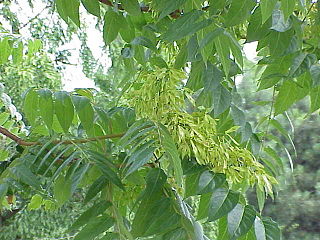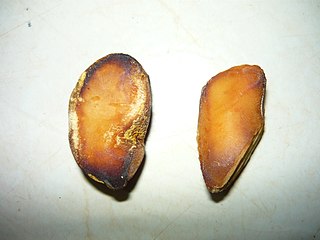
Ailanthus is a genus of trees belonging to the family Simaroubaceae, in the order Sapindales. The genus is native from east Asia south to northern Australasia.

Quassia is a plant genus in the family Simaroubaceae. Its size is disputed; some botanists treat it as consisting of only one species, Quassia amara from tropical South America, while others treat it in a wide circumscription as a pantropical genus containing up to 40 species of trees and shrubs.

Sapindales is an order of flowering plants. Well-known members of Sapindales include citrus; maples, horse-chestnuts, lychees and rambutans; mangos and cashews; frankincense and myrrh; mahogany and neem.

Joseph Marie Henry Alfred Perrier de la Bâthie was a French botanist who specialized in the plants of Madagascar.

The Simaroubaceae are a small, mostly tropical, family in the order Sapindales. In recent decades, it has been subject to much taxonomic debate, with several small families being split off. A molecular phylogeny of the family was published in 2007, greatly clarifying relationships within the family. Together with chemical characteristics such as the occurrence of petroselinic acid in Picrasma, in contrast to other members of the family such as Ailanthus, this indicates the existence of a subgroup in the family with Picrasma, Holacantha, and Castela.
Nothospondias is a genus of plants in the family Simaroubaceae. It contains the sole species Nothospondias staudtii, native to Cameroon, Côte d'Ivoire, Gabon, Ghana, and Nigeria. It is a dioecious tree.

Picramnia, the bitterbushes, is a genus of plant considered to be in the family Picramniaceae, but sometimes placed in Simaroubaceae. The name is conserved against the genera Pseudo-brasiliumAdans., and TaririAubl., both which have been rejected.

Picrasma excelsa is a species of Picrasma in the family Simaroubaceae. It is found in Cuba, the Dominican Republic, Haiti, Jamaica, Puerto Rico, Saint Vincent and the Grenadines, and Venezuela. It is threatened by habitat loss.
Pierreodendron is a genus of plants in the family Simaroubaceae.
Soulamea terminalioides is a species of plant in the Simaroubaceae family. It is endemic to Seychelles.

Soulamea is a genus of plant in family Simaroubaceae. They are shrubs or small trees, and are dioecious, with the exception of Soulamea amara, which has bisexual flowers. It is native to parts of Malesia in the West Pacific. From the Seychelles, Borneo, Bismarck Archipelago, Caroline Islands, Marshall Islands, New Caledonia, New Guinea and Maluku to the Solomon Islands, Vanuatu, and Fiji.

Castela is a genus of thorny shrubs and small trees in the family Simaroubaceae. Members of the genus are native to the Americas, especially the tropical regions. The generic name honours the French naturalist René Richard Louis Castel. Castela is dioecious, with male and female flowers on separate plants.

Jean Baptiste Louis Pierre, also known as J. B. Louis Pierre, was a French botanist known for his Asian studies.

Kirkiaceae is a family of flowering plants in the order Sapindales. It comprises one genera, Kirkia, totalling six species. These two genera were previously placed in family Simaroubaceae, but were transferred into their own family because they produce neither quassinoids nor limonoids. Kirkia is named for Captain John Kirk (explorer) of the famous Zambesi Expedition.

Harrisonia is a small genus of flowering plants in the subfamily Cneoroideae of the Rutaceae. Older taxonomic treatments have placed this genus in the Simaroubaceae.
Samadera harmandiana is a freshwater mangrove shrub or small tree in the Simaroubaceae family. It is found in Cambodia, Laos and Vietnam. The wood provides firewood. Certain fish eat the poisonous fruit
Perriera is a genus of flowering plants belonging to the family Simaroubaceae.

Simaba is a genus of flowering plants belonging to the family Simaroubaceae.
Iridosma is a monotypic genus of flowering plants belonging to the family Simaroubaceae. The only species is Iridosma letestui.
Picrolemma is a genus of flowering plants belonging to the family Simaroubaceae. They are small dioecious shrubs.












